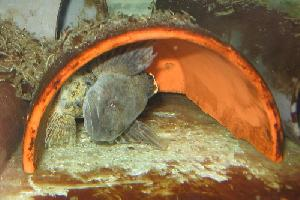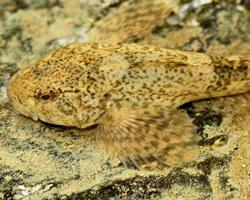
Váhy a míry
| Délka | od 100 do 150 mm |
|---|
Biologická data
| Délka života | 6 r |
|---|
Popis zvířete
The Alpine bullhead (Cottus poecilopus) is a fascinating species of freshwater fish belonging to the Cottidae family, which includes various sculpins. This species is distinguished by its remarkable adaptability and resilience, thriving in the cold, clear waters of mountain streams and lakes across Europe and Asia, from France and Norway in the west to Siberia in the east. The Alpine bullhead's distribution is primarily associated with higher altitudes, hence its common name, which reflects its preference for alpine environments.Characterized by a relatively small and robust body, the Alpine bullhead typically reaches lengths of up to 15 centimeters, though sizes can vary. Its body is somewhat elongated and covered in a mottled pattern of brown, green, and sometimes yellowish tones, camouflaging it against the riverbeds and lake bottoms where it dwells. This coloration not only serves as protection against predators but also aids in ambushing prey. The head is large and broad with a somewhat flattened appearance, featuring a wide mouth equipped with several small but sharp teeth, adapted for seizing its prey which includes invertebrates and smaller fish.
One of the most distinctive features of the Alpine bullhead is its pectoral fins, which are broad and fan-like, providing excellent maneuverability in the swift currents of its habitat. Unlike many fish species, the Alpine bullhead lacks a swim bladder, which contributes to its benthic lifestyle, allowing it to stay close to the substrate without floating away. Its pelvic fins are positioned almost directly beneath its pectoral fins, aiding in a stable and stationary posture when resting on the bottom.
The Alpine bullhead exhibits remarkable physiological adaptations to its cold-water habitat, including a high tolerance to low oxygen levels and cold temperatures, which is essential for survival in high-altitude environments where water temperatures can drop significantly. This fish is also known for its territorial behavior, especially during the breeding season, which typically occurs in spring. Males become particularly aggressive, defending nesting sites where females lay their eggs. The nests are often constructed in sheltered locations, such as under rocks or in crevices, providing protection for the eggs and later, the developing fry.
Conservation-wise, the Alpine bullhead is considered to be of least concern by the International Union for Conservation of Nature (IUCN), although local populations may be affected by environmental changes, including water pollution, habitat destruction, and the impacts of climate change. These factors can lead to decreased water quality and alterations in the flow and temperature of streams, potentially threatening the species' habitat and survival.
In summary, the Alpine bullhead (Cottus poecilopus) is a small, yet resilient fish species, equipped with a suite of adaptations for life in the fast-flowing, cold waters of mountainous regions. Its distinct appearance, behavior, and ecological role underscore the incredible diversity of life adapted to specialized environments across the globe.
Podobná zvířata
Nové fotografie zvířat
Top 10 zvířat
- Chinese water dragon (Physignathus cocincinus)
- Galápagos tortoise (Geochelone nigra complex)
- Dolphin gull (Leucophaeus scoresbii)
- Japanese macaque (Macaca fuscata)
- Colombian red howler (Alouatta seniculus)
- Sea urchins (Echinoidea)
- Moustached guenon (Cercopithecus cephus)
- Diana monkey (Cercopithecus diana)
- Common reed warbler (Acrocephalus scirpaceus)
- Common house mosquito (Culex pipiens)
